. Legends and Tales from Japan 伝説 - Introduction .
:::::::::::::::::::::::::::::::::::::::::::::::::::::::::::::::::::::::::::::::::::::::::::::::::::::::::::::::::::::::::::::::::::::::::::::::::::::::::::::::::::::::::::
gangu 玩具伝説, omochcha おもちゃ toy, toys and legends
Spielzeug und Legenden
quote
The Japanese word “omocha” meaning a toy originally means a thing to hold in a hand and play with.
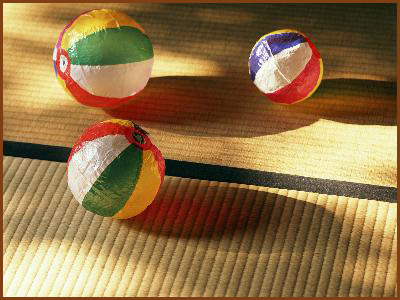
In the Heian period (794-1192), it was called “mote (or mochi)-asobimono (mote or mochi means to hold in a hand, and asobimono means something to play with),” or it was referred to as simply “asobimono” in the Tale of Genji.
In the Edo period, the word “omochi-asobi” or “te-asobi (hand play)” came to be used. Although some of the figures or masks made of clay dug out of Jomon excavation sites are considered as toys, most of the Japanese toys were originally introduced from China.
Take koma (a top) for example, this toy is called koma in Japanese because it was introduced into Japan in the Nara period (701-794) via Goguryeo (called Koma in Japanese).
Mari (a Japanese ball) was directly introduced from China during the Tang Dynasty and later it developed into “temari” for girls. After coming from China or Korea, these toys were improved and developed into something unique to each locality. Each of the traditional toys still found in various places in the country has been deep rooted in the people’s lives and religious ceremonies.
source : nippon-kichi.jp
:::::::::::::::::::::::::::::::::::::::::::::::::::::::::::::::::::::::::::::::::::::::::::::::::::::::::::::::::::::::::::::::::::::::::::::::::::::::::::::::::::::::::::
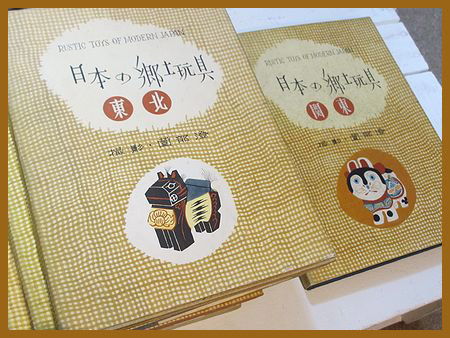
日本の郷土玩具 6 volumes by Takei Takeo 武井武雄

FOLK TOYS NIPPON にっぽんの郷土玩具
木戸昌史, 小杉 幸一 (デザイン), 岡本 充男 (写真), 田中 雄一郎 (写真)
- CLICK for more toy books
- source : amazon com -
..............................................................................................................................................
. haniwa 埴輪 Haniwa clay figures - Introduction .
haniwa gangu 埴輪玩具 Haniwa toys
:::::::::::::::::::::::::::::::::::::::::::::::::::::::::::::::::::::::::::::::::::::::::::::::::::::::::::::::::::::::::::::::::::::::::::::::::::::::::::::::::::::::::::

. Mingei Kukkii みんげいクッキー Mingei Folk Art Cookies .
:::::::::::::::::::::::::::::::::::::::::::::::::::::::::::::::::::::::::::::::::::::::::::::::::::::::::::::::::::::::::::::::::::::::::::::::::::::::::::::::::::::::::::
. Edo no shokunin 江戸の職人 Edo craftsmen .
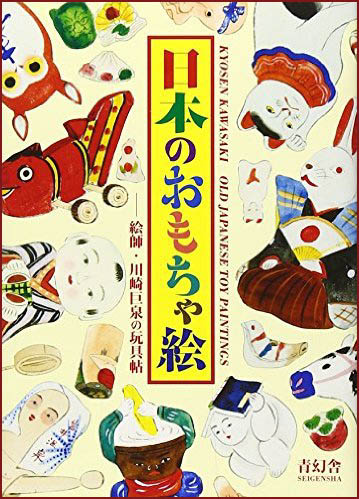
日本のおもちゃ絵 -絵師 - 川崎巨泉の玩具帖
. Kawasaki Kyosen 川崎巨泉(1877-1942) .
gangu eshi, e-shi 玩具絵師 painter of toys
These paintings were sold together with paintings for grown-ups at the shrine
. Shiba Daijinguu 芝大神宮 Shiba Daijingu .
where many book stores were located. Travelers on their way out of Edo would buy them as souvenirs for their relatives back home.
..............................................................................................................................................
kodomo ukiyo-e 子供浮世絵 Ukiyo-E for children
They contained illustrations of children playing with toys or paintings for children to play with.
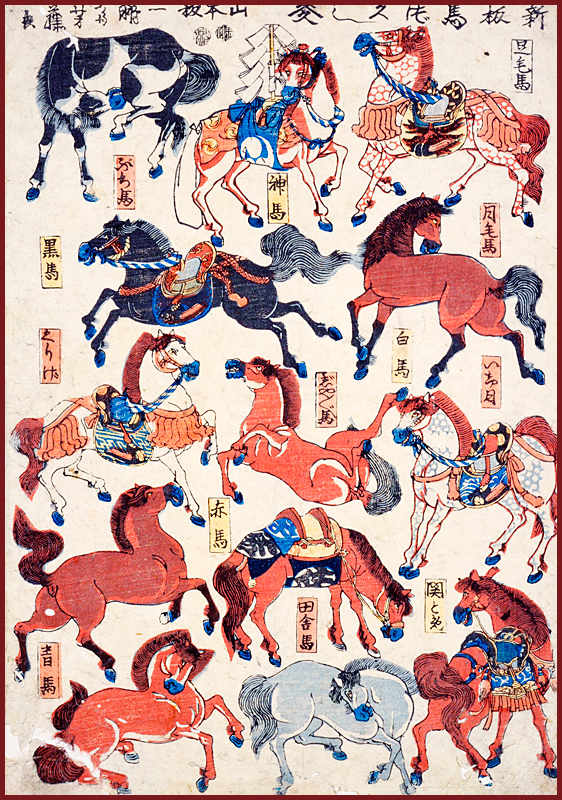
source : photo-make.jp/hm_2/shitauri_kodomo
gangu-e 玩具絵 paintings of toys
歌川芳藤 Utagawa Yoshikazu active ca. 1850–1870

- source : utinogarakuta.blog.fc2.com -
新板うさぎづくし New Collection of Rabbits
Some picture books were about special subjects to teach children about fish, flowers or animals.
- - - - - Some special types in the Daruma Museum -
. Anesama ningyoo 姉様人形 "elder sister" dolls .
Many were printed on a sheet of paper to be cut out and put together by the girls.
. gashapon ガシャポン capsule toys / gachapon (ガチャポン) .
. nishiki kage-e 錦影絵 colorful motion pictures .
. tatebanko 立版古 diorama toys .
also called
okoshi-e 起し絵 / kumiage, kumi-age 組上 / kumitate tooroo 組立燈籠
. Tabineko 旅猫雑貨店 Mingei store Tokyo Zoshigaya .
. usu to kinu 臼と杵 mortar and mallet / pestle .
from 沖縄韓流SHOP
:::::::::::::::::::::::::::::::::::::::::::::::::::::::::::::::::::::::::::::::::::::::::::::::::::::::::::::::::::::::::::::::::::::::::::::::::::::::::::::::::::::::::::

- - source: Matt Alt on twitter -
. My Gangu Toys with Daruma san .
:::::::::::::::::::::::::::::::::::::::::::::::::::::::::::::::::::::::::::::::::::::::::::::::::::::::::::::::::::::::::::::::::::::::::::::::::::::::::::::::::::::::::::
- 伝説 Legends about folk toys -
. hariko 張子 / 張り子 papermachee doll legends .
. Kappa dolls (kappa ningyoo 河童人形 ningyo) - .
. kinma 木馬(きんま) "wooden horse" toys and amulets .
. smallpox 疱瘡 伝説 Hoso - Legends about Smallpox .
red toys and prints, many with Daruma san
..............................................................................................................................................
....................................................................... Fukuoka 福岡県
.......................................................................
博多 Hakata
. Sasano Saizoo, Sasano Saizō 笹野才蔵 Sasano Saizo .
.......................................................................
久留米市 Kurume
. Suitengu 水天宮 - Kappa Dolls 河童人形 .
the Kappa Fukutaro 福太郎
....................................................................... Gunma 群馬県
高崎市 Takasaki
. Daruma Dolls - 少林山達磨寺 Shorinzan Daruma-Ji .
....................................................................... Kagawa 香川県
高松市 Takamatsu
hookoosan 奉公さん Hokosan, Hoko-San, the servant girl
. Takamatsu hariko 高松張子 papermachee dolls from Takamatsu .
.......................................................................
. hassaku dango no uma 朔だんご馬/ 八朔団子馬 horse offerings for Hassaku . - Sanuki 讃岐
. kunuki Daruma, ku nuki Daruma 苦抜き達磨 Daruma taking away the pain .
.......................................................................
男木島 Ogijima
. Momotaroo 桃太郎 Momotaro the Peach Boy .
from the Demon island 雌木島 / 女木島(鬼ヶ島)・男木島
.......................................................................
屋島町 Yashima
Tasaburo the Tanuki 太三郎狸 - Heike Tanuki 源平狸
. Temple Yashima-Ji 屋島寺 .
. Jooganji no Hage Tanuki, hagedanuki 浄願寺の禿狸 bald Tanuki from temple Jogan-Ji .
....................................................................... Kumamoto 熊本県
日奈久 Hinagu Hot Spring
. okin jo ningyoo, O-Kin おきん女人形 The Girl O-Kin .
....................................................................... Kyoto 京都府
. Mibudera, 壬生念仏 .
Many masks are sold during the 大念仏会 Nenbutsu festival.
....................................................................... Miyazaki 宮崎県
. uzuraguruma うずら車 - 鶉車 quail on wheels .
Hokedake-Ji, Hokkedakeji 法華嶽寺 Hokedake Yakushi-Ji
....................................................................... Okayama 岡山県
. Dog and Bird from Kibitsu Jinja 吉備津神社 .
....................................................................... Shiga 滋賀県
. The Tengu 天狗太郎坊 Taro-Bo .
Masks and amulets
. Tengupedia - 天狗ペディア - Tengu ABC-List .
....................................................................... Tokyo 東京 Edo 江戸
. Asakusa gangu 浅草の玩具 toys from Asakusa Kannon .
. Inari Legends from Edo 稲荷伝説 .
Kuchi-ire Inari shrine 口入稲荷神社 - and more
. Maneki Neko Beckoning Cat Legends 招き猫伝説 .
The old woman from Imado 浅草花川戸 - and more
. Tanuki Legends from Edo 狸伝説 .
Yanagimori jinja 柳森神社 oyako tanuki 親子狸 parent and child badger
Denpooin 伝法院 Denpoin, Denpo-In, Asakusa Golden Tanuki - and more
....................................................................... Tottori 鳥取県
. Kyoozooboo - The old fox Kyozobo 経蔵坊 .
. Yamata no Orochi 八俟遠呂智 / 八岐の大蛇 Serpent with eight heads .
:::::::::::::::::::::::::::::::::::::::::::::::::::::::::::::::::::::::::::::::::::::::::::::::::::::::::::::::::::::::::::::::::::::::::::::::::::::::::::::::::::::::::::
Japan: Asobi ... The Art of Playing
Celebration of traditional toys and play throughout Japan.
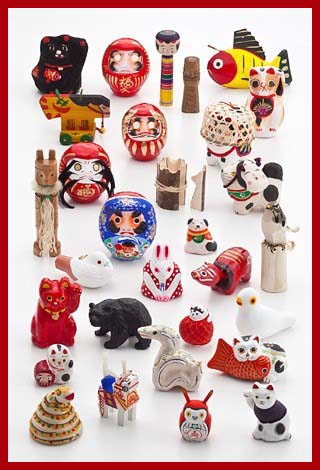
- source : pinterest collection -
:::::::::::::::::::::::::::::::::::::::::::::::::::::::::::::::::::::::::::::::::::::::::::::::::::::::::::::::::::::::::::::::::::::::::::::::::::::::::::::::::::::::::::
- source : yokai database -
玩具 94 entries to explore (37)
for mingu 民具 . . . 194 entries to explore

The museum was founded in 1974.
- source : japan-toy-museum.org -
- - - #gangutoy #toygangu - - - - -
:::::::::::::::::::::::::::::::::::::::::::::::::::::::::::::::::::::::::::::::::::::::::::::::::::::::::::::::::::::::::::::::::::::::::::::::::::::::::::::::::::::::::::
. Join the MINGEI group on facebook ! .
. Legends and Tales from Japan 伝説 - Introduction .
. Regional Folk Toys from Japan .
. Japan - Shrines and Temples .
. Tohoku after the BIG earthquake March 11, 2011
[ . BACK to WORLDKIGO . TOP . ]
[ . BACK to DARUMA MUSEUM TOP . ]
:::::::::::::::::::::::::::::::::::::::::::::::::::::::::::::::::::::::::::::::::::::::::::::::::::::::::::::::::::::::::::::::::::::::::::::::::::::::::::::::::::::::::::
No comments:
Post a Comment